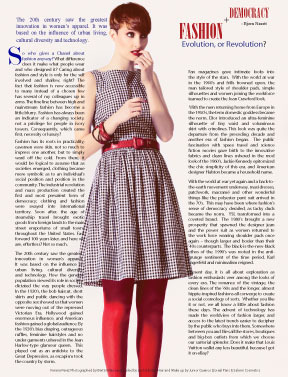
What difference does it make what people wear and who designed it? Caring about fashion and style is only for the self involved and shallow, right? The fact that fashion is now accessible to many instead of a chosen few has several of my colleagues up in arms. The fine line between high and mainstream fashion has become a little blurry. Fashion has always been an indicator of a changing society, not a privilege for people in ivory towers. Consequently, which came first, necessity or luxury?
Fashion has its roots in practicality; cavemen wore skin, not so much to impress one another, but to simply ward off the cold. From there, it would be logical to assume that as societies emerged, clothing became more symbolic as to an individual’s social position and position in the community. The industrial revolution and mass production created the first and most prevalent form of democracy; clothing and fashion were swayed into international territory. Soon after, the age of steamship travel brought exotic goods from foreign lands to the main street emporiums of small towns throughout the United States. Fast forward 100 years later, and here we are, effortless? Not so much.
The 20th century saw the greatest innovation in women’s apparel. It was based on the influence of urban living, cultural diversity and technology. How the general population viewed its role in society dictated the way people dressed. In the 1920’s, the bob haircut, short skirts and public dancing with the opposite sex showed us that women were moving out of the repressed Victorian Era. Hollywood gained enormous influence, and American fashion gained a global audience. By the 1930’s bias draping, outrageous ruffles, feminine hairstyles and no under garments ushered in the Jean Harlow-type glamour queen. This played out as an antidote to the Great Depression, as escapism took the country by storm.
Fan magazines gave intimate looks into the style of the stars. With the world at war in the 1940’s and frills frowned upon, the man tailored style of shoulder pads, simple silhouettes and women joining the workforce teamed to create the Joan Crawford look.
With the men returning home from Europe in the 1950’s, the term domestic goddess became the norm. Dior introduced an ultra-feminine silhouette of tiny waist and voluminous skirt with crinolines. This look was quite the departure from the preceding decade and another era of fashion began. The public fascination with space travel and science fiction movies gave birth to the innovative fabrics and clean lines ushered in the mod look of the 1960’s. Jackie Kennedy epitomized the chic simplicity of this era, and American designer Halston became a household name.
With the world at war yet again and a back-to- the-earth movement underway, maxi dresses, patchwork, macramé and other wonderful things like the polyester pant suit arrived in the 70’s. This may have been where fashion’s sense of democracy derailed, as tacky duds became the norm. YSL transformed into a coveted brand. The 1980’s brought a new prosperity that spawned the designer jean and the power suit as women returned to the work force wearing shoulder pads once again – though larger and boxier than their ’40s counterparts. The black-is-the-new-black ethos of the 1990’s was rooted in the anti- grunge sentiment of the time period. Karl Lagerfeld and minimalism reigned.
Present day, it is all about exploration as fashion enthusiasts veer among the looks of every era. The romance of the vintage, the clean lines of the ’60s and the longer, almost hippie-inspired fashions all converge to create a social cosmology of sorts. Whether you like it or not, we all know a little about fashion these days. The advent of technology has made the worldview of fashion larger, and access to the latest trends easier to decipher by the public who buys into them. Somewhere between you and I lies all the stores, boutiques and big-box outlets from which we choose our sartorial splendor. Does it make that Louis Vuitton wallet any less beautiful, because I got it on eBay?


Leave a Reply